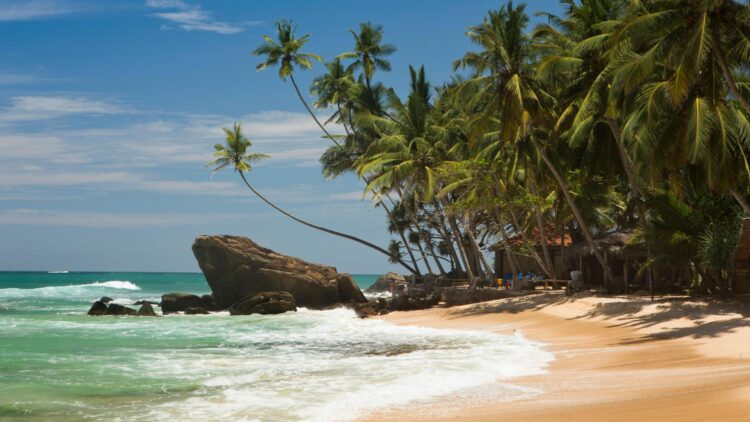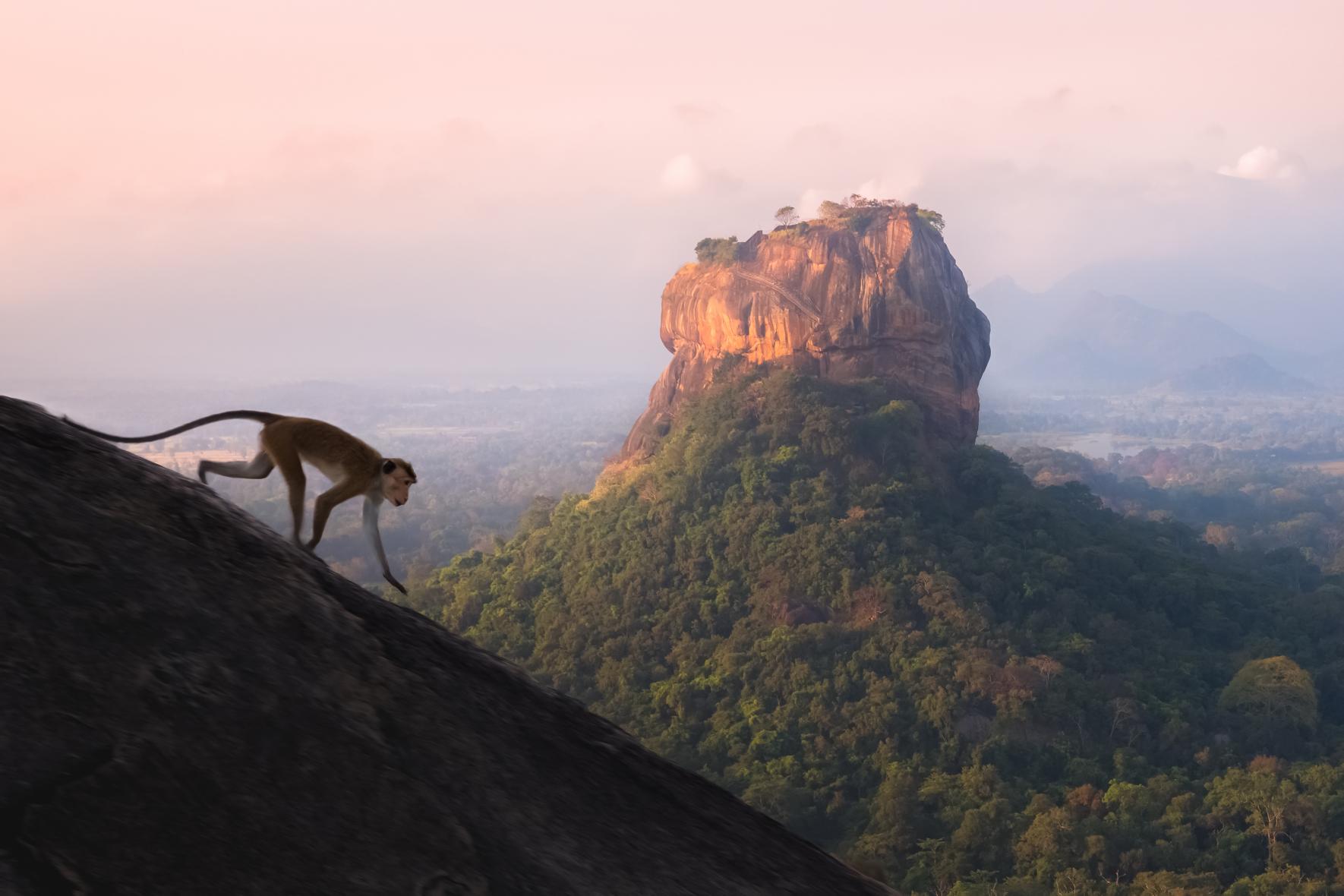It’s peaceful, it’s gorgeous — and it’s empty. The country is open to Brits again, and now is the best time to go, says Chris Haslam of The Times
COLOMBO: You’ll find Athula Nandana in the car park at the cave temples in Dambulla. He comes every day to greet tourists as they arrive and to invite them to lunch at his family-run restaurant just down the road. A bear of a man with a gappy smile, he’s offering a good deal: authentic home cooking for the tourists; a free lunch for the guide; and a livelihood for himself. Except, he says, there are no tourists.
“Before, we had maybe 600 tourists a day, 40 per cent British,” he says. “Today just six — all Spanish, none hungry. I come every day because it’s all I can do but I can only hold out for maybe three months.”
Half an hour away, there are more monkeys than tourists at Sigiriya. The 5th-century rock fortress is Sri Lanka’s Machu Picchu: a hiding place of kings atop a volcanic outcrop that juts from the plain like a beggar’s tooth. Last year, 700,000 visitors came to make the steep climb to the top. This year? “We, er, don’t have the exact figure yet,” says a ministry official, which is a diplomatic way of saying we do, but it’s so low you’ll laugh.
At the foreign visitors’ car park, 15 official guides wait for the groups that never come. Their leader, Saman Bandeira, tells me: “We had 700 British visitors per day back then. Now, maybe 10 or 15 come. Many guides have already left the industry.” Suddenly he and his colleagues are distracted as the sound of a coach — possibly carrying a tour group — comes through the jungle. Their intake of breath turns to a collective sigh as a battered bus pulls into the car park to drop off smartly uniformed kids for a school outing.
“Maybe next time,” Bandeira says, smiling.
Sri Lankans always smile, despite their woes. Nearly 30 years of civil war, the 2004 tsunami, the Easter Sunday bombings, sectarian violence and Covid have battered the island like late-season hurricanes, taking lives, destroying livelihoods and flattening the tourist industry.

The last was by far the worst.
Using a combination of ego and incompetence the Rajapaksa brothers Gotabaya, Mahinda and Basil — one was president, the other the PM and the third finance minister — have brought this nation of 22 million to the brink of collapse.
In November 2019 Gotabaya Rajapaksa announced massive tax cuts. The aim was to ingratiate himself with the electorate by putting money back into people’s pockets, but his ill-conceived plan went disastrously wrong, emptying the Central Bank and hurling the island into a whirlpool of inflation, shortages and debt.
History may record that the Rajapaksas’ one success was to unite Sri Lanka’s disparate communities into a gentle yet unstoppable force that on July 9 stormed the president’s house and stripped the regime of power — or that’s how it was reported.
A friend in Colombo showed me pictures that suggested otherwise: an orderly queue of thousands on Chatham Street, waiting as patiently as visitors to a Cotswolds stately home. Sensationalist reporting fooled governments, though, and soon France, Germany, Switzerland, Canada and the UK were among the nations advising against all but essential travel to Sri Lanka.
In late August, the Foreign, Commonwealth & Development Office lifted that advice, effectively reopening Sri Lanka to British travellers, but tour operators found clients scared of being caught in civil unrest, and guilty about taking scarce food out of Sri Lankan mouths.
And who in their right mind would want to holiday in a failing state with no social security, no petrol, businesses closing daily, shortages in the shops because no one can afford imports and a central bank on the verge of collapse?
But is it safe? In an empty hotel above the beach in Bentota I met the Colombo-based film-makers Shehaan Thahir and Shenelle Rodrigo. They’d just completed day 42 of a 43-day, 1,050-mile circumnavigation of the island by bike to find out.
“When we left Colombo friends were telling us to watch our backs,” Rodrigo says. “But wherever we went we found only kindness and concern. We’ve been invited for tea by policemen, tractor drivers, paddy workers and teachers and nowhere did we encounter hunger.”
I had to drive another 75 miles — past the empty sands of Unawatuna, Weligama and Matara — before I found the first British tourist. Backpacker Jay Milner, 22, from Essex, had arrived in the idyllic tropical cove at Hiriketiya two weeks earlier and, after consulting with the bikini-clad Dutch travellers at the £10 per night Lazy Monkey hostel, had decided to stay until the money ran out. “It’s literally heaven,” he told me.
He obviously hadn’t been to Arugam Bay on the east coast: Sri Lanka’s surfers’ paradise. Right now A-Bay should be full of novice surfers, here more for the parties than the end-of-summer swells. The bars are open and the music is thumping but only Israeli tourists, a handful of Spanish backpackers and Dutch wave hunters Henrik and Karin are in town.
“It’s crazy,” Henrik said. “We’ve had perfect waves to ourselves. We share crab curries for 2,000 rupees [£5] and walk on beaches that are the emptiest, and most beautiful, we’ve ever seen.”
He didn’t mention the hotel rates — up to 40 per cent cheaper than in 2018. The discounts will drop to about 20 per cent in December, and if tour operators pass the savings on they will all but cancel out the increases incurred by sterling’s collapse.
There are no discounts on airfares. In October 2017 you could find non-stop returns with Sri Lankan from £493 and indirects from £499 with Emirates. Today, they’re £769 and £706 — up 55 per cent and 40 per cent respectively, and the only mitigation is that the cost of holiday living — tuk-tuks, souvenirs, entry tickets and dining out — is in rupees. This time last year, you got 270 rupees to the pound. This year, it’s 411, so your money goes significantly further.
The Central Bank estimates that tourism could bring £135 million a month into Sri Lanka, providing the means to pay for critically needed imports of fertiliser, medicines and cooking gas. In the meantime, the Sri Lankans improvise, looking to their natural resources for answers.
In Pottuvil I met a 70-year-old doctor who had come out of retirement. “The schools are open, we have water and, if people have a jackfruit tree, a coconut palm or a paddy field, they’ll never starve,” he said. “I think Sri Lanka will be stronger after this ordeal.”
Last Friday I climbed Pidurangala, a lesser-known volcanic outcrop adjoining Sigiriya. Beyond the empty tourist trap, wisps of smoke rose from villages hidden in the jungle, and further still, Pettigala and Erawulgala Peak protruded from the plain like the spikes on a crocodile’s tail. That way, Kandy. The other, Colombo. Behind me, Jaffna, and somewhere in that vast landscape there had to be some British tourists. Wherever they were, they had this land of elephants, temples, tea and kindness pretty much to themselves. It’s hard to think of a better time to visit.
© The Times
Chris Haslam was a guest of Jetwing (jetwinghotels.com) and Sri Lankan Airlines (srilankan.com)





